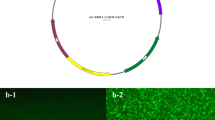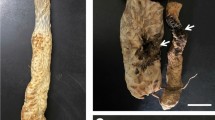Abstract
The roles of fungal diseases in the decline of standing milk-vetch pastures were investigated in field plot and glasshouse experiments in Gansu Province, China. Experimental plots within 8-, 6-, 4- and 3-year-old stands were used for measurement of plant populations and productivity, and to survey the mycobiota of root, stem and foliage tissues of healthy plants and diseased plants (showing symptoms of yellow stunt and root rot disease). Selected fungal isolates were tested for pathogenicity by inoculating 2-day-old seedlings grown in pots of sterilised soil. Plant mortality increased and plant density and productivity decreased progressively with age of stand. Of the 27 fungal species of 21 genera isolated from field-grown plants, the most frequently isolated from roots were Fusarium chlamydosporum and F. solani (other Fusarium spp. were also common), whereas Embellisia sp. and Alternaria sp. were most common from aerial tissues of diseased plants. The 11 species tested for pathogenicity could be divided into four virulent types: strongly virulent (Embellisia sp.), moderately virulent (F. oxysporum, F. chlamydosporum and F. avenaceum), weakly virulent (F. solani, F. semitectum, F. verticilloides, Conostachys rosea and Cladosporium herbarum) and non-virulent (Alternaria alternata and Alternaria sp.). Root rot caused by Embellisia sp., together with Fusarium spp. and C. rosea, appears to be the main fungal disease contributor to decline of standing milk-vetch pasture in northern China.
Similar content being viewed by others
References
Barnett HL, Hunter BB (1972) ‘Illustrated genera of imperfect fungi.’ 3rd edn. (Burgess Publishing Company: Minneapolis, MN) (Translated by Shen Chunyao, Science Press, Beijing, 1977)
Chen XR (2003) Relationship between degraded grassland and microorganisms of steppes in Gansu East as well as phylogenetic analysis and identification of the dominant microbes. PhD Thesis, Gansu Agriculture University, Lanzhou, China.
Cheng JM, Wan HE, Wang J, Yong SP (2004) Over-depletion and recovery of soil moisture on Astragalus adsurgens grasslands in the loess hilly-gully region. Acta Ecologica Sinica 24, 2979–2985.
Hou TJ (2003) Forage diseases and their control in Inner Mongolia. In ‘Forage and turfgrass pathological research in China’. (Eds ZB Nan, CJ Li) pp. 11–17. (Ocean Press: Beijing)
Hou TJ, Bai R (1986) Astragalus adsurgens diseases in Inner Mongolia and western Liaoning Province. Grassland of China 2, 40–43.
Hou TJ, Wang JF (1988) Black spot of Astragalus adsurgens and effects on forage. Grassland of China 6, 58–60.
Li YZ, Nan ZB (2007a) Symptomology and etiology of a newdisease, yellow stunt and root rot of standing milk-vetch caused by Embellisia sp. in Northern China. Mycopathologia, in press.
Li YZ, Nan ZB (2007b) First report of yellow stunt and root rot of standing milk-vetch caused by Embellisia sp. from China. New Disease Reports 15. Available at http://www.bspp.org.uk/ndr/july2007/2007-19.asp [Verified 15 May 2007]
Liu R, Hou TJ (1984) Apreliminary list of fungal diseases on forage legumes in Northern China. Grassland of China 19, 56–80.
Liu AP, Sun QZ, Hu J, Nie SM, Yan ZJ, Wang H (2003) Study on etiology of root rot of Astragalus adsurgens. Grassland of China 25, 72–74.
Nan ZB (1990) Fungal diseases of cultivated grasses and forage legumes in loess plateau of eastern Gansu Province. Pratacultural Science 7, 30–34.
Nan ZB (1998) Seed-borne fungi of Astragalus adsurgens — environment pathogenicity and control. Acta Prataculturae Sinica 7, 12–18.
Nan ZB, Liu R (1997a) Diseases of Astragalus adsurgens growing at five provinces of China and characteristics of their occurrence. Pratacultural Science 14, 30–34.
Nan ZB, Liu R (1997b) Detection of seed-borne fungi of Astragalus adsurgens. Acta Prataculturae Sinica 6, 11–16.
Nelson PE, Toussoun TA, Marasas WFO (1983) ‘Fusarium species: an illustrated manual for identification.’ (Pennsylvania State University Press: University Park, PA)
Nie SM, Sun QZ, Yan ZJ, Liu AP (2002) Studies on the effects of diverse factors affecting the decline of Astragalus adsurgens. Inner Mongolia Prataculture 14, 36–38.
Simmons EG (1971) Helminthosporium allii as type of a new genus. Mycologia 63, 380–386. doi: 10.2307/3757767
Simmons EG (1983) An aggregation of Embellisia species. Mycotaxon 17, 216–241.
Skipp RA, Christensen MJ, Nan ZB (1986) Invasion of red clover (Trifolium pratense) roots by soilborne fungi. New Zealand Journal of Agricultural Research 29, 305–313.
Sun QZ, Gui R (2000) Research on decline lawn and recovery technique of Astragalus adsurgens meadowonKerqin sand land. Acta Agrestia Sinica 8, 253–261.
Sun QZ, Gui R, Na RS, Na DMD, Zhai ZH (1999) Study on productivity of Astragalus adsurgens Pall. with different growth periods. Grassland of China 5, 29–34.
Yin YL (2004) Root invading fungi of standing milk-vetch (Astragalus adsurgens). MSc Thesis, Gansu Agriculture University, Lanzhou, China.
You MP, Barbetti MJ, Nichols PGH (2005) New sources of resistance identified in Trifolium subterraneum breeding lines and cultivars to root rot caused by Fusarium avenaceum and Pythium irregulare and their relationship to seedling survival. Australasian Plant Pathology 34, 237–244. doi: 10.1071/AP04092
Zhou HY, Yang HT, Tang WH (2004) Occurrence of Fusarium root rot in Astragalus adsurgens and identification of pathogens. Acta Agrestia Sinica 12, 285–297.
Author information
Authors and Affiliations
Corresponding author
Rights and permissions
About this article
Cite this article
Li, Y.Z., Nan, Z.B. & Hou, F.J. The roles of an Embellisia sp. causing yellow stunt and root rot of Astragalus adsurgens and other fungi in the decline of legume pastures in northern China. Australasian Plant Pathology 36, 397–402 (2007). https://doi.org/10.1071/AP07040
Received:
Accepted:
Issue Date:
DOI: https://doi.org/10.1071/AP07040




